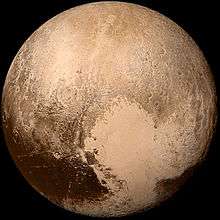38083 Rhadamanthus
| Discovery | |
|---|---|
| Discovered by | Deep Ecliptic Survey |
| Discovery date | 17 April 1999 |
| Designations | |
| MPC designation | 38083 Rhadamanthus |
| Pronunciation | /ˌrædəˈmænθəs/ RAD-ə-MAN-thəs |
Named after | Rhadamanthus |
| 1999 HX11 | |
| TNO[1][2] | |
| Adjectives | Rhadamanth(e/i)an, Rhadamanthine |
| Orbital characteristics [1][3] | |
| Epoch 13 January 2016 (JD 2457400.5) | |
| Uncertainty parameter 3 | |
| Observation arc | 3367 days (9.22 yr) |
| Aphelion | 45.204 AU (6.7624 Tm) |
| Perihelion | 33.185 AU (4.9644 Tm) |
| 39.194 AU (5.8633 Tm) | |
| Eccentricity | 0.15333 |
| 245.38 yr (89625.5 d) | |
Average orbital speed | 4.73 km/s |
| 97.148° | |
| 0° 0m 14.46s / day | |
| Inclination | 12.720° |
| 9.9615° | |
| 82.178° | |
| Earth MOID | 32.2253 AU (4.82084 Tm) |
| Jupiter MOID | 28.1835 AU (4.21619 Tm) |
| Jupiter Tisserand parameter | 5.424 |
| Physical characteristics | |
| Dimensions | 87–276 km[4][5] |
| Temperature | ~ 44 K |
| 7.1[3] | |
|
| |
38083 Rhadamanthus is a trans-Neptunian object (TNO). It was discovered in 1999 by the Deep Ecliptic Survey. It was originally thought to be a plutino but no longer is.[1][2]
Discovery and naming
Rhadamanthus was discovered on 17 April 1999 by the Deep Ecliptic Survey.
Rhadamanthus is named after the Greek mythological figure. The name was announced in the circular of the Minor Planet Center of 24 July 2002, which stated "Rhadamanthus was a son of Zeus and Europa. Because of his just and upright life, after death he was appointed a judge of the dead and the ruler of Elysium, a blissfully beautiful area of the Underworld where those favored by the gods spent their life after death. The name was suggested by E. K. Elliot."[6]
References
- 1 2 3 Marc W. Buie (7 June 2008). "Orbit Fit and Astrometric record for 38083". SwRI (Space Science Department). Retrieved 2015-10-04.
- 1 2 "MPEC 2006-X45 : Distant Minor Planets". Minor Planet Center & Tamkin Foundation Computer Network. 21 December 2006. Archived from the original on 28 August 2008. Retrieved 2008-07-18.(older provisional Plutino listing)
- 1 2 "JPL Small-Body Database Browser: 38083 Rhadamanthus (1999 HX11)" (2008-06-07 last obs). Retrieved 12 April 2016.
- ↑ Rhadamanthus
- ↑ "ABSOLUTE MAGNITUDE (H)". NASA/JPL. Retrieved 2015-09-23.
- ↑ "Minor Planet Circulars/Minor Planets and Comets, MPC-46112" (PDF). Minor Planet Center, Smithsonian Astrophysical Observatory, Cambridge, MA 02138, U.S.A. Retrieved 2015-04-19.
External links
- Orbital simulation from JPL (Java)
- Ephemeris
- 38083 Rhadamanthus at the JPL Small-Body Database
This article is issued from Wikipedia - version of the 9/10/2016. The text is available under the Creative Commons Attribution/Share Alike but additional terms may apply for the media files.
_(cropped).jpg)
